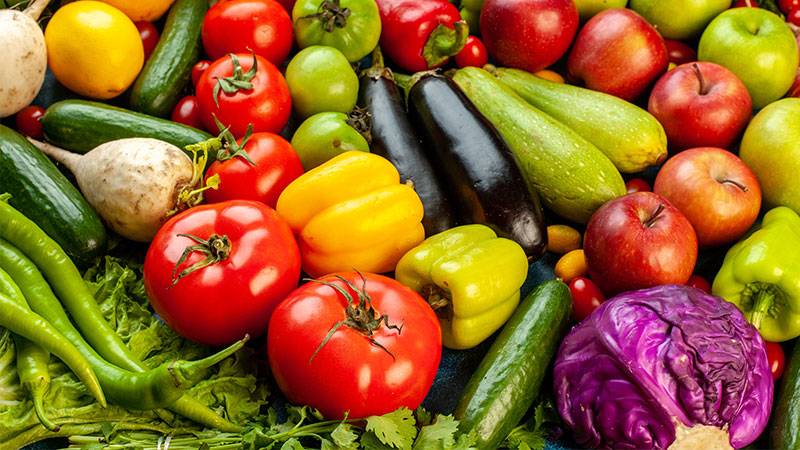Just a year ago, my dinner plate looked vastly different. Laden with processed foods and meats, it was a far cry from mindful eating.
But a documentary about climate change and a subsequent deep-dive into sustainability transformed my habits. This journey led me to the planetary health diet, a harmonious blend of nourishment and environmental consciousness. It’s more than a diet; it’s a roadmap to eating in a way that respects our bodies and the planet.
As I’ve embraced this lifestyle, I’ve seen remarkable changes in my health and a newfound appreciation for the earth’s resources. Let’s explore this life-altering diet together.
What is the Planetary Health Diet?

The Planetary Health Diet emerges from a groundbreaking collaboration between 37 scientists from around the globe, part of the EAT-Lancet Commission. This sustainable diet is a scientifically-backed blueprint designed to optimize human health while ensuring sustainable food systems for our planet.
It’s not just a diet; it’s a profound shift towards a sustainable and eco-friendly eating habit that addresses pressing issues like climate change, biodiversity loss, and non-communicable diseases.
At its core, the Planetary Health Diet emphasizes a flexitarian approach, predominantly plant-based but allowing for moderate amounts of fish, meat, and dairy.
This diet encourages a significant intake of whole grains, fruits, vegetables, nuts, and legumes, while recommending a substantial reduction in our consumption of red meat, sugar, and processed foods.
This not only aligns with nutritional guidelines but also supports agroecological practices that are crucial for maintaining biodiversity and reducing greenhouse gases.
Imagine a plate filled with colors and diversity; it’s not just visually appealing but a testament to eating with environmental and health consciousness.
The Planetary Health Diet is a call to embrace food diversity and seasonality, ensuring that our choices contribute to a sustainable future for our planet while taking care of our personal health.

Read More:
Environmental Benefits of a Planetary Health Diet

Adopting the Planetary Health Diet isn’t just a step towards better personal health; it’s a significant stride in mitigating environmental issues. This diet’s environmental benefits are profound, particularly in reducing our carbon footprint, conserving water, and optimizing land use.
Firstly, the diet’s emphasis on plant-based foods over meat is crucial in reducing greenhouse gases. Animal agriculture is a major contributor to methane and CO2 emissions.
By shifting focus to plant-based proteins, we can considerably lower our carbon footprint. For instance, producing a kilogram of beef emits 27 kg of CO2, while lentils emit less than 1 kg for the same amount. This dramatic difference illustrates the potential impact of dietary choices on climate change.
Water conservation is another critical aspect. Meat production, especially beef, requires substantial amounts of water. To produce just one pound of beef, approximately 1,800 gallons of water are needed, whereas crops like lentils require significantly less. By favoring plant-based options, the Planetary Health Diet aids in preserving our vital water resources.
Furthermore, the diet encourages efficient land use. Currently, a significant portion of arable land is dedicated to growing feed for livestock, not food for direct human consumption.
This inefficiency contributes to deforestation and biodiversity loss. By reducing meat consumption, more land can be repurposed for growing a diverse range of crops, promoting biodiversity and healthier ecosystems.
In essence, the Planetary Health Diet aligns our eating habits with the planet’s needs. It’s a sustainable choice that benefits not only our health but the environment, making it a vital component in the fight against climate change, water scarcity, and land degradation. Adopting this diet is a proactive step towards a more sustainable and eco-friendly future.
Health Benefits of a Planetary Health Diet

The health benefits of the Planetary Health Diet are as far-reaching as its environmental impacts, offering a path to wellness that aligns with global sustainability. This diet, rich in nutrient-dense foods, has been linked to a lower risk of non-communicable diseases, improved gut health, and enhanced overall well-being.
A cornerstone of this diet is its emphasis on whole grains, fruits, vegetables, nuts, and legumes, which are high in essential nutrients, fiber, and antioxidants. Studies have consistently shown that diets rich in these food groups can significantly reduce the risk of chronic diseases such as heart disease, stroke, and type 2 diabetes.
For instance, a study in the Journal of Nutrition found that a diet high in fruits and vegetables can lower blood pressure and reduce the risk of heart disease.
Moreover, the Planetary Health Diet’s focus on plant-based proteins and reduction in red meat consumption is associated with a decreased risk of certain cancers, particularly colorectal cancer.
The World Cancer Research Fund recommends a diet high in fruits, vegetables, and whole grains, and low in red meat, for cancer prevention.
Another benefit is the diet’s positive impact on gut health. The diverse range of plant-based foods contributes to a healthy gut microbiome, essential for good digestion, immune function, and even mental health.
A study published in Gut Microbes highlights the role of a plant-based diet in promoting a diverse and healthy gut microbiota.
Additionally, the moderate inclusion of fish and reduced dairy and meat aligns with nutritional guidelines, ensuring balanced intake of essential nutrients while reducing the intake of saturated fats and cholesterol.
In summary, the Planetary Health Diet is not just environmentally sustainable but also a robust framework for promoting long-term health, reducing the risk of chronic diseases, and enhancing overall quality of life.
Downsides of a Planetary Health Diet
While the Planetary Health Diet offers numerous benefits, it’s important to acknowledge potential challenges such as availability, cost, and cultural adaptations.
Availability can be a significant barrier, especially in regions where access to a diverse range of fresh produce and plant-based proteins is limited. This lack of accessibility can make adhering to the diet difficult for some.
To counter this, community initiatives like local farmers’ markets and urban gardening can play a vital role in increasing the availability of fresh, sustainable food options.
Cost is another concern. Often, organic and sustainably-sourced foods come with a higher price tag compared to conventional products. However, focusing on seasonal eating and local produce can be a cost-effective approach.
Additionally, reducing meat consumption can offset some of these costs, as plant-based proteins like lentils and beans are generally more affordable than meat.
Cultural adaptations also present a challenge. The diet may differ significantly from traditional dietary practices in some cultures, requiring a degree of modification to be more inclusive and practical. Embracing a flexible approach, where the diet is adapted to fit within cultural contexts, can make it more accessible and realistic for a broader range of people.
In essence, while the Planetary Health Diet poses certain challenges, these can be mitigated through community support, smart shopping strategies, and cultural flexibility, making it a viable option for a wide range of individuals seeking a sustainable and healthy lifestyle.
Foods to Eat on a Planetary Health Diet

The Planetary Health Diet emphasizes a balanced, diverse intake of various food groups. Here’s a breakdown of what to include in your daily diet:
Whole Grains: These are the diet’s foundation, providing essential energy, fiber, and nutrients. Aim for about 232 grams per day, which equates to around eight servings. Options include brown rice, barley, oats, and whole wheat.
Fruits and Vegetables: The diet recommends a high intake of fruits and vegetables – about 500 grams of each per day. This equates to roughly five servings of fruits and five of vegetables. Focus on a variety of colors and types to maximize nutrient intake.
Plant-Based Proteins: Legumes (beans, lentils, peas) and nuts should be a significant part of your protein intake. Aim for approximately 125 grams of legumes and 50 grams of nuts per day.
Animal Proteins: While the diet is predominantly plant-based, it allows for moderate amounts of animal proteins. This includes up to 28 grams of fish, 13 grams of poultry, and no more than 14 grams of red meat per day. Eggs and dairy (milk, cheese, yogurt) should also be consumed in moderation.
Healthy Fats: Olive oil, canola oil, and other unsaturated fats are recommended, while limiting saturated fats found in butter and lard. Aim for about 40 grams of healthy fats daily.
Added Sugars and Starchy Vegetables: Minimize the intake of added sugars and starchy vegetables like potatoes. The recommended limit is 31 grams of sugar and 50 grams of starchy vegetables per day.
This diet not only ensures a balanced and nutritious intake but also aligns with sustainable food practices, reducing environmental impact while promoting personal health. Remember, these servings are general guidelines and can be adjusted based on individual dietary needs and preferences.

Read More:
Foods to Minimize on a Planetary Health Diet

On the Planetary Health Diet, certain foods should be minimized for both environmental sustainability and health reasons. These include:
Red Meat: High consumption of red meat is linked to increased greenhouse gas emissions and health risks like heart disease and certain cancers. Limiting red meat intake is crucial for both planetary health and personal wellness.
Processed Foods: These often contain high levels of salt, sugar, and unhealthy fats. Reducing processed foods can lower the risk of non-communicable diseases and supports sustainable food systems by decreasing demand for resource-intensive production processes.
Refined Sugars: Excessive sugar intake is associated with obesity, type 2 diabetes, and other health issues. From an environmental standpoint, sugar production can be resource-intensive and often involves extensive land use.
High-Fat Dairy Products: While dairy can be part of a balanced diet, high-fat dairy products contribute to saturated fat intake. Opting for lower-fat options or plant-based alternatives can be beneficial for health and the environment.
Focusing on whole, plant-based foods and minimizing these items aligns with the goals of the Planetary Health Diet – nurturing our bodies while protecting the planet.
Tips for Trying a Planetary Health Diet
Embarking on the Planetary Health Diet can be a fulfilling journey towards sustainability and health. Here are some practical tips and simple swaps to help you transition smoothly:
Start Gradually
Don’t overhaul your diet overnight. Begin by incorporating more plant-based meals into your week. For instance, designate a couple of days as ‘meatless’ and experiment with vegetarian or vegan recipes.
Focus on Whole Foods
Base your meals around whole foods like fruits, vegetables, whole grains, legumes, and nuts. These are not only healthier but also more environmentally sustainable than processed foods.
Meat Alternatives
Try replacing red meat with plant-based proteins like lentils, chickpeas, and tofu. These are excellent sources of protein and are more sustainable. If you do consume meat, opt for sustainably sourced poultry or fish.

Seasonal and Local Eating
Purchase seasonal produce from local farmers’ markets. This supports local agriculture and reduces the carbon footprint associated with transporting food long distances.
Mindful Portions
Follow the recommended servings for various food groups in the Planetary Health Diet. This not only ensures a balanced diet but also helps in reducing food waste.
Healthy Swaps
Replace refined grains with whole grains like quinoa, brown rice, or whole wheat. Choose water or herbal teas over sugary drinks, and snack on nuts or fruits instead of processed snacks.

Plan Your Meals
Meal planning can be a game-changer. It helps in making informed choices and reduces the likelihood of opting for less sustainable or healthy options in a pinch.
Educate Yourself
Stay informed about the impact of different foods on health and the environment. Knowledge is power when it comes to making sustainable choices.
Enjoy the Diversity
Explore various cuisines that are naturally plant-based, like Mediterranean or Indian, to enjoy diverse flavors while sticking to the diet.
Be Flexible
It’s important to be flexible and adapt the diet to your individual needs and circumstances. Remember, every small step towards the Planetary Health Diet is a step towards a healthier planet and you.
Planetary Health Meal Plan for 1 Week
Embarking on the Planetary Health Diet can be both exciting and nourishing. Here’s a 7-day meal plan to get you started, showcasing a variety of plant-based recipes that are delicious and sustainable:
Day 1
Breakfast: Oatmeal topped with fresh berries and a sprinkle of nuts.
Lunch: Quinoa salad with mixed greens, cherry tomatoes, cucumber, and a lemon-olive oil dressing.
Dinner: Stir-fried tofu with broccoli, bell peppers, and brown rice.
Day 2
Breakfast: Whole grain toast with avocado and a side of seasonal fruit.
Lunch: Lentil soup with carrots, onions, and celery, served with a slice of whole grain bread.
Dinner: Baked salmon with a side of roasted sweet potatoes and steamed green beans.
Day 3
Breakfast: Smoothie with spinach, banana, almond milk, and a tablespoon of flaxseeds.
Lunch: Chickpea salad with a variety of fresh vegetables and a tahini dressing.
Dinner: Whole wheat pasta with tomato sauce, grilled vegetables, and a side salad
Day 4
Breakfast: Greek yogurt with granola and honey.
Lunch: Vegetable stir-fry with tofu, served over quinoa.
Dinner: Grilled chicken breast with a quinoa and black bean salad.
Day 5
Breakfast: Scrambled eggs with spinach, tomatoes, and whole grain toast.
Lunch: Veggie wrap with hummus, cucumber, carrot, and lettuce.
Dinner: Baked cod with lemon and herbs, served with a side of asparagus and brown rice.
Day 6
Breakfast: Chia seed pudding topped with fresh fruit and a drizzle of honey.
Lunch: Brown rice bowl with black beans, avocado, salsa, and a sprinkle of cheese.
Dinner: Vegetable curry with chickpeas, served with whole grain naan.
Day 7
Breakfast: Pancakes made with whole grain flour, topped with fresh fruit.
Lunch: Lentil and vegetable stew, served with a side of whole grain bread.
Dinner: Grilled shrimp with a mixed green salad and a vinaigrette dressing.
Conclusion
In conclusion, the Planetary Health Diet offers a profound opportunity to positively impact both our health and the environment. By emphasizing whole grains, plant-based proteins, and a variety of fruits and vegetables, this diet aligns with sustainable food practices. It not only reduces our carbon footprint and conserves vital resources but also supports a lifestyle that can prevent non-communicable diseases and promote overall well-being.
Embracing this diet means playing a part in the crucial fight against climate change and contributing to a healthier planet. I encourage you to explore this sustainable eating path and experience its benefits for yourself and our world.

